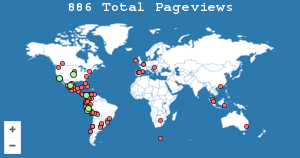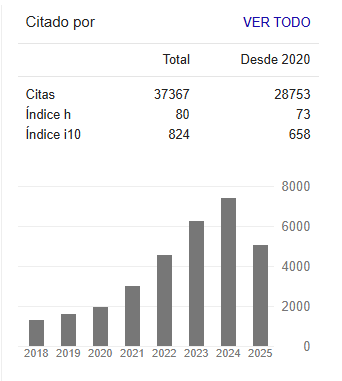Legitimidad y reputación corporativa: estudio a partir de normas de sistemas de gestión ISO
Resumen
El objetivo de este artículo es analizar el impacto de la certificación en las normas de sistemas de gestión ISO 9001 e ISO 14001 y de su implementación en un sistema integrado de gestión (SIG) sobre la legitimidad y la reputación de las organizaciones, así como contrastar la influencia de dichos activos intangibles en el rendimiento financiero. Como complemento a este objetivo se estudió la posible relación bidireccional entre los dos activos intangibles. Para ello se han seleccionado las empresas del IBEX-35, y se ha utilizado una modelización estructural con PLS. Los resultados evidencian una influencia positiva entre la certificación con la legitimidad y con la reputación, entre la integración de los sistemas de gestión con la legitimidad, y entre la legitimidad y la reputación con el rendimiento financiero. Sin embargo, no se ha podido evidenciar la relación entre la integración de los dos sistemas de gestión con la reputación. Se concluye que la implementación en las organizaciones de manera independiente o integrada de normas ISO 9001 e ISO 14001 va a permitir responder a las empresas a las expectativas del entorno y grupos sociales, mejorando tanto su legitimidad como su reputación.Citas
AIMC (2020). Marco General de los medios en España.https://www.aimc.es/blog/aimc-lanza-marco-general-los-medios-espana-2020-diversas-novedades/
Akdag, H. & Zineldin, M. (2011). Strategic positioning and quality determinants in banking service. The TQM Journal, 23(4). 446-457.
Bansal, P. & Clelland, I. (2004).Talkingtrash: Legitimacy, impression management, andun systematic risk in the context of the natural environment. Academyof Management Journal, 47(1). 93-103.
Barreto, I. & Baden-Fuller, C. (2006). To conform or to perform? Mimetic behaviour, legitimacy-based groups and performance consequences. Journal of Management Studies,43(7). 1559-1581.
Bernardo, M., Simón, A., Tarí, J.& Molina-Azorín, J. (2015). Benefits of management systems integration: a literature review. Journal of Cleaner Production, 94, 260-267.
Bernardo, M.,Gotzamani, K., Vouzas, F. &Casadesús, M. (2016). A qualitative study on integrated management systems in a non-leading country in certifications. Total Quality Management & Business Excellence, 29(3-4). 453-480.
Bhuiyan, N. &Alam, N. (2005). An investigation into issues related to the latest version of ISO 9000. Total Quality Management and Business Excellence, 16(2). 199-213.
Boiral, O. (2007). Corporate greening through ISO 14001: a rationalmyth? Organization Science, 18(1). 127-146.
Boiral, O. (2011). Managingwith ISO Systems: Lessons from Practice.Long Range Planning, 44(3). 197-220.
Boiral, O.& Henri, J. (2012). Modelling the impact of ISO 14001 onenvironmental performance: A comparative approach. Journalof Environmental Management, 99, 84-97.
Boiral, O., Guillaumie, L. Heras-Saizarbitoria, I. &Tayo, C. (2018). Adoption and Outcomes of ISO 14001: A Systematic Review. International Journal of Management Reviews, 20, 411-432.
Carreras, E., Alloza, Á. & Carreras, A. (2013). Reputación corporativa. Editorial Empresarial.
Corbett, C., Montes-Sancho, M. &Kirsch, D. (2005). The financial impactof ISO 9000 certification in the US: anempiricalanalysis. Management Science, 51 (7), 1046-1059.
Costa, I., Callen, J., Branco, M. & Curto, J. (2014). The Value Relevance of Reputation for Sustainability Leadership. Journal of Business Ethics, 119(1). 17-28.
Cruz-Suárez, A., Prado-Román, C. &Díez-Martín, F. (2014). Por qué se institucionalizanlasorganizaciones. Revista Europea de Dirección y Economía de la Empresa, 23(1). 22–30.
Czinkota, Michael, Kaufmann, Hans., &Basile, Gianpaolo (2014). The relation ship between legitimacy, reputation, sustainability and branding for companies and their supply chains. Industrial Marketing Management, 43(1). 91-101.
Darnall, N., Jolley, J. & Handfield, R. (2008). Environmental management systems and green supply chain management: complements for sustainability? Business Strategy and theEnvironment, 17(1). 30-45.
De Castro, G. (2008). Reputación empresarial y ventaja competitiva. ESIC Editorial.
Deephouse, D., Bundy, J., Tost, L. & Suchman, M. (2016).Organizational Legitimacy: Six Key Questions. SagePublications.
Deephouse, D. & Carter, S. (2005).Anexamination of differences between organizational legitima cyand organizational reputation. Journalof Management Studies, 42(2). 329-360.
Deephouse, D. & Suchman, M. (2008).Legitimacy in Organizational Institutionalism. The Sage handbook of organizational institutionalism, 49-77.
Deephouse, D. (1996). Does isomorphism legitimate?.Academy of Management Journal, 39(4). 1024-1039.
Delmas, M. & Montes-Sancho, M. (2011). AnInstitutional Perspective on the Diffusion of International Management System Standards: The Case ofthe Environmental Management Standard ISO 14001. Business Ethics Quarterly, 21(1). 103-132.
Díez-Martín, F., Blanco-González, A. & Prado-Román, C. (2016).Explainingnation-widedifferences in entrepreneurial activity: a legitimacy perspective. International Entrepreneurship and Management Journal, 12(4). 1079-1102.
Fombrun, C. (1996). Reputation: Realizing value from the corporate image. Harvard Business School Press, Boston.
Fombrun, C. & Shanley, M. (1990). What’s in a name? Reputation buildingand corporat estrategy. Academy of Management Journal, 33(2). 233–258.
Fonseca, L., Domingues, J., Machado, P. & Calderón, M. (2017). Management system certificationbenefits: where do we stand? Journalof Industrial Engineeringand Management, 10(3). 476-494.
Fonseca, L. & Domingues, J. (2018). EmpiricalResearchofthe ISO 9001:2015 TransitionProcess in Portugal: Motivations, Benefits, andSuccessFactors. Quality Innovation Prosperity, 22(2). 16-46.
Gavronski, I., Ferrer, G. y Paiva, E L. (2008).ISO 14001 certification in Brazil: motivations and benefits. Journal of Cleaner Production, 16(1). 87-94.
Gotzamani, K. & Tsiotras, G. (2002).The true motives behind ISO 9000 certification: Their effect on the overall certification benefits and long term contribution towards TQM. International Journal of Quality & Reliability Management, 19(2). 151-169.
Guler, I., Guillen, M. & MacPherson, J.(2002). Global Competition, Institutions, and the Diffusion of Organizational Practices: The International Spread of ISO 9000 Quality Certificates. Administrative Science Quarterly, 47(2). 207-232.
Hair, J., Hult, T., Ringle, C. & Sarstedt, M. (2016).A Primer on Partial Least Squares Structural Equation Modeling (PLS—SEM). 2ª Ed. Thousand Oaks: CA: Sage.
Heras, I. (2011). General perspectives on the leading international management standards. Journal of Management Research, 11(1). 3-19.
Heras, I., Arana, G. & San Miguel, E. (2010). An Analysis of the Main Drivers for ISO 9001 and other Isomorphic Metastandards. Review of International Comparative Management, 11(4). 562-574.
Heras, I., Arana, G. & Molina-Azorín, J. (2011). Do drivers matter for the benefits of ISO 14001?. International Journal of Operations and Production Management, 31, 192–216.
Heras, I. & Boiral, O. (2013). ISO 9001 and ISO 14001: towards a research agenda on management system standards. International Journal of Management Reviews, 15(1). 47-65.
ISO (2018). ISO survey 2018. http://www.iso.org/iso/iso-survey
Jones, R., Arndt, G. y Kustin, R. (1997). ISO 9000 among Australian companies: impact of time and reasons for seeking certification on perceptions of benefits received. International Journal of Quality& Reliability Management, 14(7). 650-660.
King, B. & Whetten, D. (2008). Rethin king the relation ship between reputation and legitimacy: A social actor conceptualization. Corporate Reputation Review, 11(3). 192-207.
Khanna, H., Laroiya, S.C. & Sharma, D.D. (2010). Integrated management systems in Indian manufacturing organizations: some key findings from an empirical study. The TQM Journal, 22(6). 670-686.
Lo, C., Wiengarten, F., Humphreys, P., Yeung, A. & Cheng T.C.E. (2013). The impactof contextual factorsontheefficacyof ISO 9000 adoption. Journal of Operations Management, 31(5). 229-235.
Llopis, J. &Tarí, J. (2003). The importance of internal aspects in quality improvement. International Journal of Quality & Reliability Management, 20(3). 304-324.
Lloyd, S. (2011).Triangulation research to in form corporate reputation theory and practice. Corporate Reputation Review, 14(3). 221-233.
Luc, P., Marimón, F. & Casadesús, M. (2013).Can ISO 9001 improve service recovery? Industrial Management & Data Systems, 113(8). 1206-1221.
Nunhes, T., Ferreira, L. & Oliveira, O. (2016). Evolution of integrated management systems research on the Journal of Cleaner Production: identification of contributions and gaps in the literature. Journal of Cleaner Production, 139, 1234-1244.
Nunhes, T., Bernardo, M. & Oliveira, O. (2018). Guiding principles of integrated management systems: Towards unifying a starting point for researchers and practitioners. Journal of Cleaner Production, 210, 977-993.
Oliver, C. (1997). Sustainable competitive advantage: Combining institutional and resource based views. Strategic Management Journal, 18, 697-713.
Orcos, R., Pérez-Aradros, B. & Blind, K. (2018).Why does thediffusionofenvironmental management standards differacross countries? The role of formal and informal institutions in theadoptionof ISO 14001. Journalof World Business, 53(6). 850-861.
Orviz, N. (2017). Influencia de los sistemas de gestión en la legitimidad y reputación de las organizaciones, y de estos activos intangibles en su rendimiento financiero. Tesis (Dr). Madrid, España, Universidad Rey Juan Carlos.
Prajogo, D., Tang, A. & Lai, K-h. (2012). Do firmsgetwhattheywantfrom ISO 14001 adoption? an Australian perspective. Journal Cleaner Production, 33, 117-126.
Prajogo, Daniel (2011). The roles offirms’ motives in affecting the out comes of ISO 9000 adoption. International Journal of Operations & Production Management, 31(1). 78-100.
Qi, G., Zeng, S., Yin, H. & Lin, H. (2013).ISO and OHSAS certifications. Management Decision, 51(10). 1983-2005.
Rhee, M. & Haunschild, P. (2006).The liability of good reputation: A studyofproduct recalls in the U.S. automobileindustry. Organization Science, 17(1). 101-117.
Rindova, V., Williamson, I., Petkova, A. & Sever, J. (2005). Being good orbeing known: Anempirical examination of the dimensions, antecedents, and consequences of organizational reputation. Academy of Management Journal, 48(6). 1033-1049.
Roberts, P. & Dowling, G. (2002). Corporate reputationandsustained superior financial performance. Strategic management journal, 23(12). 1077-1093.
Ruef, M. & Scott, R. (1998). A multidimensional model of organizational legitimacy: Hospital survival in changing institutional environments. Administrative Science Quarterly, 43(4). 877-904.
Ruiz, B., Gutiérrez, S. & Esteban, Á. (2012). Desarrollo de un concepto de reputación corporativa adaptado a lasnecesidades de lagestión empresarial. Strategy& Management Business Review, 3(1). 9-31.
Sampaio, P., Saraiva, P. & Rodrigues, A. (2010). A classification model for prediction of certification motivations from the contents of ISO 9001 audit reports. Total Quality Management and Business Excellence, 21(12). 1279-1298.
Sampaio, P., Saraiva, P. & Rodrigues, A. (2009). ISO 9001 certification research: questions, answers and approaches. International Journal of Quality & Reliability Management, 26(1). 38-58.
Shamma, H. (2012). Toward a comprehensive understanding of corporate reputation: Concept, measurement and implications. International Journal of Business and Management, 7(16). 151-169.
Simón, A., Karapetrovic, S. & Casadesús, M. (2012). Difficulties and benefits of integrated management systems. Industrial Management & Data Systems, 112(5). 828-846.
Suchman, M. (1995). Managing legitimacy: strategic and institutional approaches. Academy of Management Review, 20(3). 571-610.
Tarí, J. & Molina-Azorín, J. (2010).Integration of quality management and environmental management systems: Similarities and the role of the EFQM model. The TQM Journal, 22(6). 687-701.
Tarí, J., Molina-Azorín, J. & Heras, I. (2012). Benefits of the ISO 9001 and ISO 14001 standards: A literature review. Journal of Industrial Engineering and Management, 5(2). 297-322
Walker, K. (2010). A systematic review of the corporate reputation literature: Definition, measurement, and theory. Corporate Reputation Review, 12(4). 357-387.
Yin, H. & Schmeidler, P. (2009). Why do standardized ISO 14001 environmental management systems lead to heterogeneous environmental outcomes?. Business Strategy and the Environment, 18(7). 469-486
Zhu, Q., Cordeiro, J. &Sarkis, J.(2013). Institutional pressures, dynamic capabilities and environmental management systems: Investigating the ISO 9000 — Environmental management system implementation linkage. Journal of Environmental Management, 114, 232-242.
Zimmerman, M. & Zeitz, G. (2002). Beyond survival: achieving new venture growth by building legitimacy. Academy of Management Review, 27(3). 414-31.








.png)






























